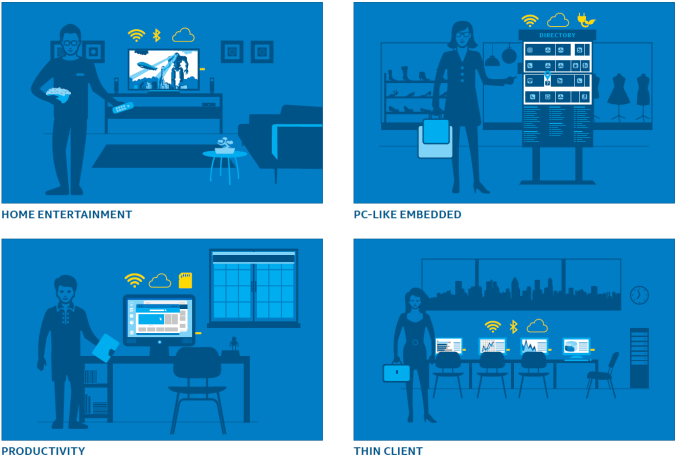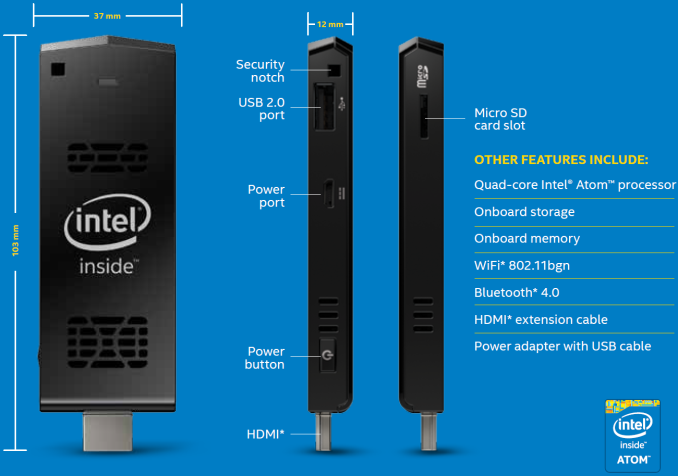Intel PPSTCK1A32WFC Bay Trail-T Compute Stick Review
by Ganesh T S on April 22, 2015 11:00 AM EST- Posted in
- Systems
- Intel
- Bay Trail
- HDMI Stick
Concluding Remarks
The Intel Compute Stick gave us the opportunity to see whether a tablet SoC could provide enough horsepower for a desktop PC. Based on our experience, the answer to that question is cautiously in the affirmative. There is no doubt that the device can do well as an economical solution for thin clients, kiosks and digital signage. These are scenarios where only one program runs for the life of the system and the OS is rarely updated.
The Compute Stick could do with some improvements for the scenarios in the left column
Traditional PCs have a different use-case compared to PC-like embedded systems and that brings us to the first problem in the Compute Stick we reviewed:
- OS drive size
32 GB, simply put, is just not enough after Windows installs a couple of updates. Out of the box, the system had around 17 GB free in the 23 GB disk (the rest, presumably, is the OS recovery partition). An initial update check resulted in a 1.3 GB download, and that installation brought down the free space to 14.3 GB. We have always been wary of Windows Updates on machines with low free space on the primary drive. As feared, attempting to install another round of updates resulted in a botched update problem (solved here). We had to spend 4+ hours getting the unit back to the initial state with a 'refresh' operation (and reinstall all the updates once again). To top it off, Windows lost activation in the refresh process and refused to reactivate (indicating a blacklisted key).
- Thermal design / solution
There is no doubt that the thermal design is very effective. Acoustic measurements come in at 28 dB at 1m distance. However, the irregular nature of the small-diameter fan makes for a strained experience if the user sits very close to the Compute Stick (possible in an office environment). It would not be a bad idea to go for a passively cooled Compute Stick at the cost of a slight increase in cost, weight and/or size.
- WLAN solution
The unit doesn't come with any wired networking facilities. It is essential that the Wi-Fi solution be top-notch. Unfortunately, a single-band 1x1 802.11n solution just doesn't cut it - particularly for scenarios involving video streaming. Thankfully, the presence of Bluetooth makes a USB keyboard / mouse unnecessary, freeing up the single USB 2.0 port for other purposes. Talking of video streaming, it would also be nice to have full HD audio support in the GPU drivers for Bay Trail-T (now that it has made its appearance in a mini-PC).
Despite the above shortcomings, the Compute Stick did impress us in a few areas - the form factor and portability aspects are praiseworthy. The CPU performance is not as bad as we feared it would be - Windows loads in a smooth manner and the system is as responsive as what one can expect from a Bay Trail-based mini-PC.
Coming to the business end of the review, we can say that the Intel Compute Stick is a typical first-generation product. In our opinion, there are way too many compromises being made to get to this form factor. There are certainly applications where the kit would be perfect, but general-purpose day-to-day computing is not one of them. If Intel wants the Compute Stick product line to take off like NUCs, addressing the three main shortcomings detailed above would be a good first step.












103 Comments
View All Comments
uzm - Wednesday, April 22, 2015 - link
can it output 4K desktop? I'm looking for something that can drive an image slideshow on a 4K TV.zeo - Monday, April 27, 2015 - link
Probably better off considering something like the Surface 3 with Cherry Trail, the new Gen 8 GPU is significantly better than Bay Trail's Gen 7 GPU and the display port should easily handle a 4K display better than most models with HDMI output...Bansaku - Wednesday, April 22, 2015 - link
I wonder if you could Hackintosh it?azazel1024 - Wednesday, April 22, 2015 - link
I don't know how that can be considered an effective thermal solution. Maybe it is how tiny the chasis is. In my T100 with the z3740 (and plastic chasis, but obviously a larger chasis than the compute stick, but the compute stick has active cooling), I hit 1.83-1.86GHz and the CPU will stay pegged there under max load. I don't think I've ever monitored it for more than ~10 minutes, but running handbrake on it to test, it loaded all 4 cores at 95-99% and over the course of 10 minutes it never dropped the CPU frequency below that 1.83-1.86GHz range.The brief bit of testing (VERY brief) running some games (Kerbal space program actually) my T100 runs (after a minute or two to settle the thermals) the CPU at 1.33-1.6GHz generally and the GPU at around 450MHz or so with some brief bursts on both up towards 1.7GHz and 650MHz respectively.
Also 8w sounds like a LOT of power. Back to the whole KSP thing, I can get a little over 5 hours of battery life on my T100 running KSP, which is on a 31hwr battery, which equates to about 6 watts of average consumption under heavy CPU and GPU load (okay, probably not be as high as prime + furmark) for the ENTIRE platform, SoC, memory, screen, keyboard dock, etc. I'd be shocked if the SoC itself was drawing more than 4w.
ganeshts - Wednesday, April 22, 2015 - link
For this chassis size, I will call the thermal solution effective since the CPU is running at the rated 1.3 GHz without throttling for more than 30 minutes, all the while maintaining the temperature below 85 C for the CPU package. The only time I would call a thermal solution ineffective is if it allows the CPU to reach junction temperature or makes the CPU run at less than rated speed.azazel1024 - Thursday, April 23, 2015 - link
I guess that is a point, but since it seems to throttle within just a couple of seconds back towards or to base clock, I think I'd call that thermal solution marginal. Does the processor melt down or throttle below base clock? No, but at the same time, the turbo core speeds seem close to worthless, because only occasionally would you ever see them.At least something that can manage to hit max turbo for 10-20s, you would likely see real benefits of that in a lot of light work loads, but here you'd only get to experience it for very, very brief periods of time (perhaps a webpage load, but you aren't going to see it in an application load even).
zodiacfml - Wednesday, April 22, 2015 - link
Pricey but its probably tested to run 24 7 on a display for ads....than cheaper intel windows tablets. Id reccomend this at my work.valnar - Wednesday, April 22, 2015 - link
The WiFi speed is barely adequate, and that is only 20' away. Given the single radio, any issues whatsoever and video would hiccup. I think for about the same price or a little more, it would be safer to have a slightly bigger box. 'Something in the NUC range. After all, you aren't really saving that much space, and the thing still needs a power plug anyway.cen - Wednesday, April 22, 2015 - link
It pisses me off to no end when Anandtech does not test Linux with these devices.CharonPDX - Wednesday, April 22, 2015 - link
Not a fail to me - just a very specific set of use cases.Micro HTPC (car-PC?)
"Always with you" desktop PC you can plug in to just about any TV (along with a micro Bluetooth keyboard/mouse combo.)
Business "thin client" type PC.
Full-function Raspberry Pi replacement.